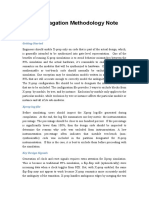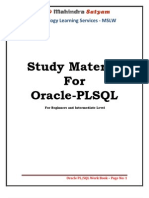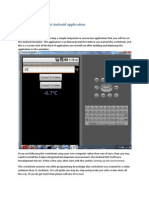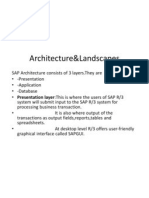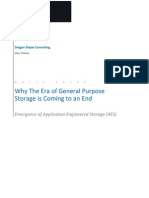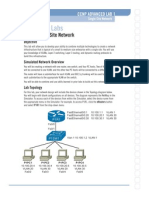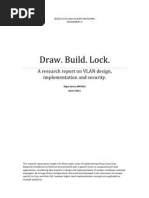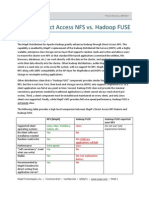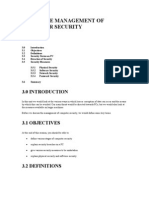0 ratings0% found this document useful (0 votes)
97 viewsEE282 Final Exam: Solutions
EE282 Final Exam: Solutions
Uploaded by
EAGLEFORCE06This document contains the solutions to an exam for a computer systems architecture course. It provides instructions for taking the exam, which is closed book but allows for one page of notes. The exam contains multiple choice and short answer questions about topics relating to computer systems including caches, prefetching, memory allocation policies, disk architectures, virtualization, multicore processors, and error detection/correction.
Copyright:
© All Rights Reserved
Available Formats
Download as PDF, TXT or read online from Scribd
EE282 Final Exam: Solutions
EE282 Final Exam: Solutions
Uploaded by
EAGLEFORCE060 ratings0% found this document useful (0 votes)
97 views9 pagesThis document contains the solutions to an exam for a computer systems architecture course. It provides instructions for taking the exam, which is closed book but allows for one page of notes. The exam contains multiple choice and short answer questions about topics relating to computer systems including caches, prefetching, memory allocation policies, disk architectures, virtualization, multicore processors, and error detection/correction.
Original Description:
Exam.spring10.Sols
Original Title
Exam.spring10.Sols
Copyright
© © All Rights Reserved
Available Formats
PDF, TXT or read online from Scribd
Share this document
Did you find this document useful?
Is this content inappropriate?
This document contains the solutions to an exam for a computer systems architecture course. It provides instructions for taking the exam, which is closed book but allows for one page of notes. The exam contains multiple choice and short answer questions about topics relating to computer systems including caches, prefetching, memory allocation policies, disk architectures, virtualization, multicore processors, and error detection/correction.
Copyright:
© All Rights Reserved
Available Formats
Download as PDF, TXT or read online from Scribd
Download as pdf or txt
0 ratings0% found this document useful (0 votes)
97 views9 pagesEE282 Final Exam: Solutions
EE282 Final Exam: Solutions
Uploaded by
EAGLEFORCE06This document contains the solutions to an exam for a computer systems architecture course. It provides instructions for taking the exam, which is closed book but allows for one page of notes. The exam contains multiple choice and short answer questions about topics relating to computer systems including caches, prefetching, memory allocation policies, disk architectures, virtualization, multicore processors, and error detection/correction.
Copyright:
© All Rights Reserved
Available Formats
Download as PDF, TXT or read online from Scribd
Download as pdf or txt
You are on page 1of 9
1
LL282: CompuLer SysLems ArchlLecLure Sprlng 2010
SLanford unlverslLy !une 9
Lh
, 2010
LL282 llnal Lxam SoluLlons
!"#$ &'()*+,)-.'(/ Answer each of Lhe quesLlons lncluded ln Lhe exam. WrlLe all of your answers dlrecLly on Lhe examlnaLlon
paper, lncludlng any work LhaL you wlsh Lo be consldered for parLlal credlL. 1he examlnaLlon ls closed book, buL you can make
use of one page of noLes and a calculaLor. ?ou may noL use a compuLer or browser of any klnd.
0' 12+#)-.'(/ Wherever posslble, make sure Lo flrsL wrlLe Lhe equaLlon wlLh symbollc Lerms, Lhen Lhe equaLlon rewrlLLen wlLh
Lhe numerlcal values, and Lhen Lhe flnal soluLlon. arLlal credlL wlll be welghLed approprlaLely for each componenL of Lhe
problem, and provldlng more lnformaLlon lmproves Lhe llkellhood LhaL parLlal credlL can be awarded.
0' 3*-)-'4 ,.51/ unless oLherwlse sLaLed, for any answers LhaL requlre code examples or fragmenLs, you should wrlLe C-llke
pseudocode. ?ou do noL need Lo opLlmlze your code unless speclflcally lnsLrucLed Lo do so. CommenLs for any code are noL
sLrlcLly requlred on Lhe exam, buL are hlghly recommended. 1hey may help you recelve parLlal credlL on a problem, lf Lhey help
us deLermlne whaL you were Lrylng Lo do.
0' )-$1/ ?ou wlll have )6*11 6.+*( 789: $-'+)1(; Lo compleLe Lhls exam. 8udgeL your Llme and Lry Lo leave
some aL Lhe end Lo go over your work. 1he polnL welghLlngs correspond roughly Lhe dlfflculLy of each problem. lf you flnd a
problem Loo dlfflculL aL flrsL, move on Lo Lhe oLher problems and revlslL lL laLer.
name (prlnL) ___________________________________________________________________
Leland username ___________________________________ SCu SLudenL (?/n) ___________
<=! ><?@A0BC D@&E!B>&<F =0@0B G0C!
1he Ponor Code ls an underLaklng of Lhe sLudenLs, lndlvldually and collecLlvely:
(1) LhaL Lhey wlll noL glve or recelve ald ln examlnaLlons, LhaL Lhey wlll noL glve or recelve unpermlLLed ald ln class
work, ln Lhe preparaLlon of reporLs, or ln any oLher work LhaL ls Lo be used by Lhe lnsLrucLor as Lhe basls of
gradlng,
(2) LhaL Lhey wlll do Lhelr share and Lake an acLlve parL ln seelng Lo lL LhaL oLhers as well as Lhemselves uphold Lhe
splrlL and leLLer of Lhe Ponor Code.
l acknowledge and accepL Lhe Ponor Code.
name (slgn) __________________________________________________________
Score Crader
roblem 1 27 ________ ______
roblem 2 40 ________ ______
roblem 3 33 ________ ______
1oLal (100) HHHHHH
2
I*.JK1$ 8/ <61 <*+)6 3-KK >1) F.+ A*11 LMN O.-')(P
lndlcaLe lf Lhe followlng sLaLemenLs are 1rue or lalse. rovlde a slngle senLence [usLlflcaLlon for
your answer. Answers wlLhouL [usLlflcaLlon wlll recelve no credlL. [3 polnLs per sLaLemenL]
a) Assume LhaL you are dolng a uMA Lransfer from memory Lo an l/C devlce. Also assume LhaL,
ln addlLlon Lo readlng u8AM you also need Lo read Lhe processor caches LhaL may be cachlng
addresses lnvolved ln Lhe u8AM Lransfer. lf an L2 cache read produces a hlL, Lhen lL musL be
forward Lo Lhe L1 cache for an addlLlonal lookup aL LhaL level.
l - lL needs Lo be forward Lo Lhe L1 cache only lf Lhe cache llne ls dlrLy (or suspecLed Lo be dlrLy)
b) SofLware prefeLchlng can only be lmplemenLed lf Lhe hardware lmplemenLs non-blocklng
caches.
1 - oLherwlse Lhe processor would lmmedlaLely sLall on Lhe prefeLch lnsLrucLlon
c) 1he memory allocaLlon pollcles used by sofLware can affecL Lhe power consumpLlon of Lhe
sysLem.
1 - lL can affecL Lhe number of u8AM banks/ranks/ulMMs/channels LhaL are acLlve ln order Lo
serve a program (as opposed Lo belng ln sLandby or low power modes)
d) 1he mosL lmporLanL meLrlc when bulldlng a daLa cenLer ls low energy consumpLlon.
l - 1oLal cosL of ownershlp (1CC) ls Lhe mosL lmporLanL one
e) When scallng down Lhe volLage and clock frequency of a processor, Lhe rlghL order ls Lo flrsL
reduce Lhe power supply volLage and Lhen reduce Lhe clock frequency.
l - you flrsL need Lo reduce Lhe frequency as elecLronlcs work slower aL lower volLages
f) uslng vlrLually-addressed caches ln a processor leads Lo lower energy consumpLlon compared
Lo a processor wlLh physlcally-addressed caches.
1 - poLenLlally yes because you can sklp LranslaLlon for accesses LhaL hlL ln Lhe L1
g) lor 8Alu-3, Lhe acLual number of dlsk accesses necessary Lo wrlLe a slngle byLe ls 2.
l - lL's acLually 4 (read old value/parlLy, wrlLe new value/parlLy)
h) 8Alu-1 lmproves Lhe performance of read accesses.
1 - you can send a read access Lo elLher dlsk
l) ln a vlrLual machlne envlronmenL, l/C lnLerrupLs are flrsL processed by Lhe vlrLual machlne
monlLor and Lhen by Lhe lnLerrupL handler of Lhe guesL CS.
1 - Lhe oLher way around ls unsafe as an l/C lnLerrupL may acLually be for anoLher guesL
3
I*.JK1$ M/ &' )61.*QR O*#,)-,1 #'5 )61.*Q #*1 )61 (#$1 LS: O.-')(P
rovlde shorL answers Lo Lhe followlng quesLlons. 1yplcally, a few senLences or a shorL bulleLed
llsL wlll be sufflclenL. A long explanaLlon ls llkely Lo lnclude some lncorrecL sLaLemenL, so keep lL
shorL and Lo Lhe polnL.
a) rovlde one speclflc example for each of Lhe followlng Lop-10" approaches for lmprovlng
energy efflclency ln compuLer sysLems. Lach example should be no longer Lhan one senLence.
1he example can be from any class of sysLems (noLebooks, smarLphones, daLacenLers) and can
be a sysLem-level, chlp-level, or sofLware Lechnlque. [10 polnLs]
use energy-efflclenL Lechnologles: use flash lnsLead of dlsks
MaLch power Lo work: dynamlc volLage-frequency scallng when load ls low
MaLch work Lo power: reduce Lhe frame raLe for vldeo playback when low on baLLery
lggy back energy evenLs: lnLerrupL coalesclng Lo amorLlze overheads
Speclal-purpose soluLlons: use Cus, uSs, or oLher speclal funcLlon unlLs
Cross-layer efflclency: workload consolldaLlon and scale-down ln daLacenLer
1radeoff some oLher meLrlc: sLore 2 lnsLead of 3 coples of daLa ln a daLa cenLer
1radeoff Lhe uncommon case: provlslon for a lower performance load Lo avold excesslve energy
cosLs ln power supply or coollng
Spend somebody else's power: cllenL sends compuLaLlon Lo server (assumlng communlcaLlon
cosL ls lower Lhan compuLaLlon cosL)
Spend power Lo save power: compress daLa Lo be able Lo Lurn off some memory/dlsk
componenLs
4
b) rocessor vendors are uslng Lhe exponenLlally lncreaslng LranslsLor budgeLs Lo lnclude
mulLlple cores per chlp. Lven lf we assume LhaL we have a large number of lndependenL
programs or Lasks Lo run ln parallel on Lhe cores, whaL may be Lwo facLors LhaL llmlL Lhe
usefulness of Lhe a mulLl-core chlp? [4 polnLs - 2 polnLs each]
- ower consumpLlon and power denslLy: you may noL be able Lo provlde power or remove
heaL lf all Lhe processors ln Lhe chlp are worklng concurrenLly. lor example, Lhe heaL removal
capablllLles are proporLlonal Lo Lhe area of Lhe chlp so Lhey remalned flxed as we puL an
lncreaslng number of processors ln Lhe same space.
- Memory & l/C bandwldLh: Lhe collecLlve memory and l/C bandwldLh of all Lhe appllcaLlons
may exceed Lhe bandwldLh avallable for off-chlp communlcaLlon. 1he off-chlp bandwldLh
depends on Lhe number of plns of Lhe chlp, whlch ln Lurn depends on Lhe area of Lhe chlp.
Pence, Lhe bandwldLh does noL scale wlLh Lhe number of processor we squeeze ln one chlp.
c) CerLaln companles propose LhaL we should operaLe daLa-cenLers wlLhouL acLlve alr-
condlLlonlng (aka alr-slde economlzaLlon). 1hls lmplles LhaL Lhe servers ln Lhe daLa cenLer wlll
be operaLlng aL a hlgher LemperaLure. WhaL ls Lhe Lradeoff you should Lo sLudy Lo evaluaLe lf
Lhls ls a good ldea? [4 polnLs]
lL ls an lssue of balanclng cosLs. Cn Lhe one hand you have Lhe cosL of buylng machlnes. ln
classlcal daLa-cenLers wlLh alr condlLlonlng, you pay for new machlnes every 3 years. WlLhouL
alr condlLlonlng lL wlll be more ofLen. lf LhaL exLra cosL/year ls less Lhan whaL you save from noL
paylng for alr condlLlonlng (equlpmenL, energy, eLc), Lhen lL's a good ldea.
2 Lo reallze lL's a cosL lssue, 2 Lo explaln a Lradeoff beLween cosL of PW replacemenL and cosL of
coollng.
5
d) Messages ln lnLerconnecL neLworks Lyplcally use error deLecLlng buL noL error correcLlng
codes (as lL ls Lhe case ln memorles and dlsks). uescrlbe brlefly how you can provlde error
correcLlon ln neLworks wlLhouL Lhe use of error correcLlng codes. WhaL are Lhe advanLages of
your proposal over [usL uslng error-correcLlng codes for Lhe conLenLs of each message? WhaL
are Lhe lmplemenLaLlon requlremenLs of your proposal? [6 polnLs]
?ou can use reLransmlsslon Lo do error correcLlon. Cnce a message ls declded Lo be lncorrecL or
losL, Lhen we can reLransmlL lL. 8eLransmlsslon requlres bufferlng of messages aL Lhe sender,
reorderlng capablllLles ln Lhe recelver, an acknowledgemenL proLocol, and a LlmeouL
mechanlsm Lo deLecL losL messages. 1he advanLages are:
- lL works even lf you geL many errors ln one message (more Lhan whaL a cosL-effecLlve
error deLecLlng code can supporL)
- lL works even lf Lhe whole message ls losL
2 polnLs Lo menLlon reLransmlsslon, 2 polnLs Lo explaln a llLLle how lL works/requlremenLs
1 polnLs for each advanLage
e) A sysLem can recover from errors by Laklng perlodlcal checkpolnLs of lLs sLaLe and reverLlng
Lo one of Lhem when an error ls deLecLed. LlsL Lhe facLors you would conslder Lo selecL Lhe
frequency of checkpolnLlng Lhe sysLem sLaLe and Lhe number of acLlve checkpolnLs malnLalned
by Lhe sysLem. [6 polnLs]
- 1he laLency of error deLecLlon
- 1he sLorage overhead (for boLh a slngle checkpolnL and all Lhe checkpolnLs)
- 1he Llme Lo resLore one or more checkpolnLs for recovery.
6 polnLs, 2 for each polnL
6
f) Assume an l/C sysLem wlLh a uMA conLroller LhaL can supporL mulLlple, concurrenLly acLlve,
uMA requesLs. Slnce all uMA requesLs go over Lhe same memory bus, some arblLraLlon
mechanlsm ls necessary. LlsL Lhe facLors LhaL Lhe uMA conLroller could Lake lnLo accounL ln
arblLraLlng beLween Lhe requesLs and why Lhey are lmporLanL. noLe: you should noL explaln a
speclflc arblLraLlon pollcy, buL Lhe facLors LhaL could be Laken lnLo accounL ln varlous pollcles. [4
polnLs]
- Channel sLaLus: some uMA Lransfers may be blocked. L.g., one channel may be movlng daLa
from memory Lo dlsk. Slnce dlsks are slow, LhaL uMA channel wlll be blocked qulLe ofLen.
- LocallLy/CranularlLy: due Lo locallLy effecLs, lL may be fasLer Lo group requesLs from one
channel and execuLe Lhem back-Lo-back raLher Lhan swlLch beLween channels afLer every
requesL.
- SofLware-deflned prlorlLles
- lalrness (lf Lhere are no prlorlLles)
g) A processor uses 32-blL physlcal addresses and 32-blL vlrLual addresses wlLh 1-k8yLe pages.
1he processor's 1L8 has 128 enLrles and ls 4-way seL assoclaLlve. WhaL ls Lhe sLorage as ln Lhe
number of S8AM blLs (or kblLs = 1024 blLs) requlred Lo lmplemenL Lhe 1L8? Assume LhaL each
enLry lncludes Lhree permlsslon blLs (8, W, x) and LhaL replacemenL uses a randomlzed
algorlLhm. [6 polnLs]
1he 32-blL vlrLual address lncludes Lwo flelds: 10 blL page offseL and 22 blL vlrLual page number.
1he 22-blL vn ls Lhe address for Lhe 1L8. 1he 1L8 has 128 enLrles organlzed ln 4 ways of 32
enLrles each. So, we need Lo exLracL a 3-blL lndex from Lhe vn ln order Lo selecL one of Lhese
32-enLrlers. 1he remalnlng 22-3=17blLs of Lhe vn wlll be Lhe Lag for Lhe 1L8.
So, each 1L8 enLry has a valld blL, 17blLs of 1ag, 22 blLs of physlcal page number (n - Lhe
LranslaLlon resulL), and 3 permlsslon blLs. 1oLal 43 blLs. 1here ls no need for L8u blLs
(randomlzed replacemenL).
So Lhe LoLal cosL of Lhe 1L8 ls 128 enLrles * 43 blLs = 3304 blLs = 3.373kblLs
-1 polnL for forgeLLlng Lhe valld blL
-1 polnL for forgeLLlng Lhe permlsslon blLs
-1 for addlng oLher random blLs Lo Lhe enLry
-1 lf you geL Lhe n lengLh wrong, -2 lf you forgeL lL compleLely
-2 for a 22b Lag (-1 lf Lhe calculaLlon of a 17b Lag fleld ls wrong)
7
I*.JK1$ T/ U+) -' O*#,)-,1R )61Q #*1 5-VV1*1') LTT O.-')(P
a) Assume Lhe followlng C code LhaL scans a llnked-llsL daLa-sLrucLure.
current = head; // start from the head of the linked list
while (current!=NULL) { // while list is not empty
process (current->element); // do some work on the current element
current = current->next; // go to the next element
}
Clven a sysLem wlLh Lwo processors LhaL share Lhe same flrsL-level daLa cache, how would
you prefeLch Lhe llnked-llsL daLa for Lhe above Lraversal? under whaL condlLlons would Lhe
prefeLchlng scheme be successful? [10 polnLs]
A slmple prefeLchlng scheme ls Lo have Lhe second processor execuLe a slmpllfled" verslon of
Lhe loop LhaL does no work buL prefeLches elemenLs for Lhe flrsL processor.
1he prefeLch loop wlll look llke:
current = head; // start from the head of the linked list
while (current!=NULL) { // while list is not empty
fetch(current->element); // no work, just fetch in cache
current = current->next; // go to the next element
}
1hls approach wlll work well lf Lhe process() funcLlon ln Lhe flrsL processor lncludes slgnlflcanL
amounL of work Lo hlde Lhe memory laLency of Lhe mlss for each elemenL. 1hls allows Lhe 2nd
processor Lo be a few elemenLs ahead of Lhe flrsL one.
We should also noLe LhaL lf Lhe laLency of process() ls much hlgher Lhan LhaL of Lhe mlss, Lhe
2nd processor may run Loo far ahead causlng desLrucLlve lnLerference ln Lhe cache. lL probably
makes sense Lo synchronlze Lhe Lwo processors perlodlcally.
6 polnLs for descrlblng a scheme LhaL seems Lo work
4 polnLs for dlscusslng Lhe plus/mlnus
8
b) Assume you are deslgnlng a new, large-scale daLacenLer wlLh 100,000 servers. ?our goal ls Lo
operaLe Lhe daLacenLer wlLh a slngle Lechnlclan responslble for hardware repalrs. Lach server
repalr Lakes 1 hour and cosLs $130 ln labor and 10 of Lhe server's cosL for replacemenL parLs.
Assume a full-Llme Lechnlclan works 40 hours a week 48 weeks ouL of Lhe year. WhaL ls Lhe
maxlmum annual fallure raLe LhaL you can LoleraLe for Lhe servers? [4 polnLs]
Assume LhaL Lhe fallure raLe ls x. We wanL Lhe LoLal Llme needed Lo repalr servers Lo be less
Lhan Lhe Llme a full-Llme Lechnlclan can work ln a year.
8epalr Llme < Lechnlclan's Llme !
x*1h*100,000servers < 48 weeks * 40 hours/week !
x <0.0192 or x<1.9 fallure raLe.
Assume LhaL you have Lwo cholces of servers for your daLacenLer. Server A cosLs $2,000 per
unlL and has an annual fallure raLe of 0.03. Server 8 cosLs $2,300 has an annual fallure raLe
0.013. Server 8 also provldes hlgher performance so 90,000 servers wlll be sufflclenL Lo Lhe
daLacenLer. Assumlng a 3-year llfeLlme for servers, whlch server Lype should you use for your
daLa cenLer? Show your work. [6 polnLs]
lor each Lype of server, Lhere are Lwo cosLs Lo conslder: caplLal expenses (cosL of buylng Lhe
servers) and operaLlonal expenses (cosL of repalrlng Lhe servers). 1he operaLlonal expenses
lnclude replacemenL parLs and repalr Llme
CosL A = $2k/server*100,000servers + 3 years*3*100,000*(1h*$130/hour+10*$2,000) =
$200M + $3.23M = $203.23M
CosL 8 = $2.3/server*90,000servers + 3 years*1.3*100,000*(1h*$130/hour+10*2,300) =
$223M + $1.620M = $226.620M
Cbvlously, Lhe caplLal expenses domlnaLe so server A ls Lhe rlghL way Lo go.
9
c) Conslder Lhe followlng graph LhaL explores Lhe laLency of sLrlded accesses on Lhe cache
hlerarchy of a well-known mlcroprocessor chlp. Clven Lhls graph, answer Lhe followlng
quesLlons. rovlde a 1 senLence [usLlflcaLlon for each answer. [13 polnLs]
WhaL ls Lhe L1 u-cache llne slze? 648
WhaL ls Lhe assoclaLlvlLy of Lhe L1 u-cache? 4-way
WhaL ls Lhe slze of Lhe L1 u-cache? 16k8
WhaL ls Lhe slze of Lhe L2 cache? 236k8
WhaL ls Lhe assoclaLlvlLy of Lhe L2 cache? 8-way
You might also like
- Harvard Management Company CaseDocument5 pagesHarvard Management Company Casetrololol1234567No ratings yet
- X-Propagation Methodology Note: Getting StartedDocument4 pagesX-Propagation Methodology Note: Getting StartedRamu CherkupallyNo ratings yet
- Ghana Manual For DHIMS 2Document48 pagesGhana Manual For DHIMS 2Los Rog100% (3)
- Oracle PLSQL WorkbookDocument146 pagesOracle PLSQL WorkbookNarendra Reddy75% (8)
- Diagrama Electrico 416FDocument34 pagesDiagrama Electrico 416FPlstina Rams100% (2)
- You Can Have An Amazing Memory - PDF PDF ExpertDocument4 pagesYou Can Have An Amazing Memory - PDF PDF ExpertrajuNo ratings yet
- Axe - O - Ma (C DSP User Guide: v1.1.4, October 19, 2012Document18 pagesAxe - O - Ma (C DSP User Guide: v1.1.4, October 19, 2012Martin MoergenroetNo ratings yet
- Sap Hana Speaks Sqlscript en 2014-01-08Document5 pagesSap Hana Speaks Sqlscript en 2014-01-08Vivekananda CharyNo ratings yet
- Assignment 1Document5 pagesAssignment 1breakzNo ratings yet
- ENGR 103 - Spring 2014 Freshman Engineering Design LabDocument6 pagesENGR 103 - Spring 2014 Freshman Engineering Design LabAnmol AroraNo ratings yet
- Poc Guide For VsanDocument36 pagesPoc Guide For VsannewbeoneNo ratings yet
- Sky Spark White PaperDocument7 pagesSky Spark White PaperJohn KablerNo ratings yet
- So#Ware Defined Networks and Openflow: Nanog 50, October 2010Document39 pagesSo#Ware Defined Networks and Openflow: Nanog 50, October 2010darkisildurNo ratings yet
- Graphic Slicing TipDocument22 pagesGraphic Slicing TipNguyễn Trọng QuốcNo ratings yet
- Developing Your First Android Application: Chris Loftus and Andy StarrDocument24 pagesDeveloping Your First Android Application: Chris Loftus and Andy StarrAnkit KumarNo ratings yet
- Safe Rigging Practices NZ DraftDocument17 pagesSafe Rigging Practices NZ DraftAptaeex ExtremaduraNo ratings yet
- Oracle MongoDB ReplicationDocument14 pagesOracle MongoDB ReplicationSaeed MeethalNo ratings yet
- Rb951Ui 2HnD QG ManualDocument4 pagesRb951Ui 2HnD QG ManualAsep AcengNo ratings yet
- Embedded System DesignDocument12 pagesEmbedded System DesignDharmendra TripathiNo ratings yet
- Comparison Oracle and Microsoft SQL: Edition Benefits Price SupportDocument4 pagesComparison Oracle and Microsoft SQL: Edition Benefits Price SupportLuis EcheniqueNo ratings yet
- Networking EssentialsDocument45 pagesNetworking EssentialsK Krishna ChaitanyaNo ratings yet
- AIX Interview Questions and AnswersDocument13 pagesAIX Interview Questions and AnswersAsif MuzaffarNo ratings yet
- Cmos Vlsi Design Lab 4: Controller Design: 1. Standard Cell LibraryDocument8 pagesCmos Vlsi Design Lab 4: Controller Design: 1. Standard Cell LibraryTrần TriềuNo ratings yet
- Country India Version (C.I.N) : Q&A CIN V.1.0Document16 pagesCountry India Version (C.I.N) : Q&A CIN V.1.0rajasekeranmadNo ratings yet
- Lec 33Document55 pagesLec 33Ankur SinghNo ratings yet
- TDQDocument27 pagesTDQkodandaNo ratings yet
- Public Art Project OverviewDocument6 pagesPublic Art Project Overviewapi-246404186No ratings yet
- Introduction to PL SQL1Document29 pagesIntroduction to PL SQL1TUSHAR BONDENo ratings yet
- Snort Rule Cheat Sheet: Header FormatDocument2 pagesSnort Rule Cheat Sheet: Header FormatalucianNo ratings yet
- PL/SQL Workbook: For Use in Association WithDocument20 pagesPL/SQL Workbook: For Use in Association WithGanapathiraju SravaniNo ratings yet
- PLSQL PrintDocument96 pagesPLSQL PrintnagkkkkkNo ratings yet
- SRLabs BadUSB BlackHat v1Document22 pagesSRLabs BadUSB BlackHat v1Saksbjørn IhleNo ratings yet
- C CCCC/CCCC) CCCCCCDocument16 pagesC CCCC/CCCC) CCCCCCMuhammad Rizwan ArainNo ratings yet
- ToastMasters InvestingDocument7 pagesToastMasters InvestingJames PeetNo ratings yet
- Lab 3 Summer 2013Document8 pagesLab 3 Summer 2013Chi Toan Dang TranNo ratings yet
- Guide For Vendors - TàDocument44 pagesGuide For Vendors - TàPhạm An AnNo ratings yet
- ArchitectureDocument17 pagesArchitectureBhaskar ReddyNo ratings yet
- Mòdul 0. Introducció A L'assignatura: Programació de Controls NumèricsDocument8 pagesMòdul 0. Introducció A L'assignatura: Programació de Controls NumèricsEduardo PinedaNo ratings yet
- Opensap Hana1 WarmupDocument73 pagesOpensap Hana1 Warmupsouthern_baNo ratings yet
- OracleProf - 2004 - 05Document16 pagesOracleProf - 2004 - 05JMendezTrNo ratings yet
- VMware Cloud HostingDocument7 pagesVMware Cloud HostingbastonesNo ratings yet
- North J. OverbyDocument4 pagesNorth J. OverbynoverbyNo ratings yet
- Hamaker 2.2.1Document23 pagesHamaker 2.2.1frox123No ratings yet
- Application Engineered Storage ZfsDocument11 pagesApplication Engineered Storage ZfsAdrian BorleaNo ratings yet
- A Technical Overview of CouchbaseDocument96 pagesA Technical Overview of CouchbasevulttNo ratings yet
- D 1 JCLDocument15 pagesD 1 JCLSiju V ThomasNo ratings yet
- CAPMDocument30 pagesCAPMleolau2015No ratings yet
- WiNG 5.X How To - Mesh ConnexDocument59 pagesWiNG 5.X How To - Mesh ConnexDenya_bitNo ratings yet
- Networking BasicsDocument60 pagesNetworking BasicsShubhra Pahwa GoelNo ratings yet
- 62CFD NonNewt Flow Rudman 2013Document2 pages62CFD NonNewt Flow Rudman 2013Irfan ShaikhNo ratings yet
- So, Ware: Instruc (On SetDocument16 pagesSo, Ware: Instruc (On SetRohan JainNo ratings yet
- Comparch Comparch-002 Exams Midterm A8Xj46NCRoDocument9 pagesComparch Comparch-002 Exams Midterm A8Xj46NCRoMattia LeNo ratings yet
- Advanced Labs: Lab 1: Single Site NetworkDocument10 pagesAdvanced Labs: Lab 1: Single Site NetworkCesar Morera AlpizarNo ratings yet
- G53NMD 2014 Individual Coursework - Malaysia PresentationDocument1 pageG53NMD 2014 Individual Coursework - Malaysia PresentationHein Min HtikeNo ratings yet
- Assignment 2 0947853Document10 pagesAssignment 2 0947853Nigel Terry SanouNo ratings yet
- Oracle Interview Questions and Answers: SQL: 1. To See Current User NameDocument18 pagesOracle Interview Questions and Answers: SQL: 1. To See Current User NameswarooperNo ratings yet
- De' (F9.g'%hf@@"5i%: JKH%L!"#$M% N"8++#%kohd% N"8++#%kohd%'e#+59'8% +G'5%JKH%Document6 pagesDe' (F9.g'%hf@@"5i%: JKH%L!"#$M% N"8++#%kohd% N"8++#%kohd%'e#+59'8% +G'5%JKH%mani_idNo ratings yet
- CcnaDocument14 pagesCcnaAnurag AmbashtNo ratings yet
- Ttingstarted Guide Opendaylight-2Document19 pagesTtingstarted Guide Opendaylight-2Vignesh GouthamNo ratings yet
- ORACLE PL/SQL Interview Questions You'll Most Likely Be AskedFrom EverandORACLE PL/SQL Interview Questions You'll Most Likely Be AskedRating: 5 out of 5 stars5/5 (1)
- Oracle SQL Revealed: Executing Business Logic in the Database EngineFrom EverandOracle SQL Revealed: Executing Business Logic in the Database EngineNo ratings yet
- Elgg 1.8 Functions Cheatsheet: Plugin Initialization Actions, Input, Forms Viewing DataDocument1 pageElgg 1.8 Functions Cheatsheet: Plugin Initialization Actions, Input, Forms Viewing DataEAGLEFORCE06No ratings yet
- Please If Are The Boss Don't Read This Ok? Please If Are The Boss Don't Read This Ok?Document1 pagePlease If Are The Boss Don't Read This Ok? Please If Are The Boss Don't Read This Ok?EAGLEFORCE06No ratings yet
- Get In. Stand Out.: We Can Help You Build Your First Windows Phone App, and Be Part of The App RevolutionDocument7 pagesGet In. Stand Out.: We Can Help You Build Your First Windows Phone App, and Be Part of The App RevolutionEAGLEFORCE06No ratings yet
- Architecture Chapter4 E5 2012Document92 pagesArchitecture Chapter4 E5 2012EAGLEFORCE06No ratings yet
- Computer Architecture Ee454 HW#4Document1 pageComputer Architecture Ee454 HW#4EAGLEFORCE06No ratings yet
- Grad Ind StudyDocument2 pagesGrad Ind StudyEAGLEFORCE06No ratings yet
- OLD DAT105 Exercise4Document31 pagesOLD DAT105 Exercise4EAGLEFORCE06No ratings yet
- Computer Architecture HW#3Document1 pageComputer Architecture HW#3EAGLEFORCE06No ratings yet
- AP Physics Chapter 9 Review SheetDocument9 pagesAP Physics Chapter 9 Review SheetEAGLEFORCE06No ratings yet
- Building Applications With Oracle Jdeveloper (10.1.3.2.0) : License To Use This Student GuideฺDocument34 pagesBuilding Applications With Oracle Jdeveloper (10.1.3.2.0) : License To Use This Student GuideฺDebadrita GhoshNo ratings yet
- Connecting Rod Bearings - InstallDocument3 pagesConnecting Rod Bearings - InstallPutra JawaNo ratings yet
- MYP Unit 2Document8 pagesMYP Unit 2katiesav5006064No ratings yet
- Fiamm FLB Battery 2016Document4 pagesFiamm FLB Battery 2016Tanveer AhmedNo ratings yet
- Tank Inspection Standard Operating Procedures PDFDocument3 pagesTank Inspection Standard Operating Procedures PDFIfroz KhanNo ratings yet
- Actuator L120-85 Multi-Turn: Instruction & Maintenance ManualDocument60 pagesActuator L120-85 Multi-Turn: Instruction & Maintenance ManualansliNo ratings yet
- GSM - Addresses and IdentifiersDocument3 pagesGSM - Addresses and IdentifiersFereidoun SadrNo ratings yet
- Basic Windows Shortcut KeysDocument10 pagesBasic Windows Shortcut KeysKaren LauNo ratings yet
- Implications of Globalisation For TVET CurriculumDocument8 pagesImplications of Globalisation For TVET CurriculumGakon100% (3)
- Lab 1: Analysis and Planning: Subject: Software EngineeringDocument6 pagesLab 1: Analysis and Planning: Subject: Software EngineeringDuy ĐỗNo ratings yet
- Repro Times Talks About The Evolving World of Publishing Volume: 01 Issue: 01Document4 pagesRepro Times Talks About The Evolving World of Publishing Volume: 01 Issue: 01Repro India LimitedNo ratings yet
- Placement-Statistics-BIT Sindri - 19-23-WebsiteDocument14 pagesPlacement-Statistics-BIT Sindri - 19-23-WebsiteRaHul VerMaNo ratings yet
- RTU 6049E70 MiniDocument2 pagesRTU 6049E70 MiniImran WaheedNo ratings yet
- Ofr02 166Document101 pagesOfr02 166DCSAWNo ratings yet
- DMB Manual en 201002Document17 pagesDMB Manual en 201002Shesharam ChouhanNo ratings yet
- Coils Cat 0838Document78 pagesCoils Cat 0838sinasayedanaNo ratings yet
- J S University FormateDocument4 pagesJ S University FormateTahir HussainNo ratings yet
- Cabling Techniques With Diagram:: Straight CableDocument4 pagesCabling Techniques With Diagram:: Straight CableGaurav BasuNo ratings yet
- GV 2500A GV 3800A GV 5600A GV 6600A: GeneratorDocument74 pagesGV 2500A GV 3800A GV 5600A GV 6600A: Generatorjose capoteNo ratings yet
- OpenGL Data Visualization Cookbook - Sample ChapterDocument47 pagesOpenGL Data Visualization Cookbook - Sample ChapterPackt PublishingNo ratings yet
- Rebuilding of Ahmadi Township Project - (PHASE 2-2) : SSL 4.495 MDocument1 pageRebuilding of Ahmadi Township Project - (PHASE 2-2) : SSL 4.495 Mأحمد حسنNo ratings yet
- DSN-VC288 Volts Amps Panel MeterDocument4 pagesDSN-VC288 Volts Amps Panel Meterruss.junkNo ratings yet
- Cs302 Assignment 2 SolutionDocument2 pagesCs302 Assignment 2 Solutionaamir shahzadNo ratings yet
- TenderingDocument30 pagesTenderingPriyanka Satalkar100% (1)
- A Tool For Preliminary Design of Rockets: Diogo Marques Gaspar July 2014Document10 pagesA Tool For Preliminary Design of Rockets: Diogo Marques Gaspar July 2014BalakumarNo ratings yet
- Learning Alfresco Web Scripts Sample ChapterDocument16 pagesLearning Alfresco Web Scripts Sample ChapterPackt PublishingNo ratings yet
- Unit 3 NETWORK AND SECURITYDocument9 pagesUnit 3 NETWORK AND SECURITYdev chauhanNo ratings yet


